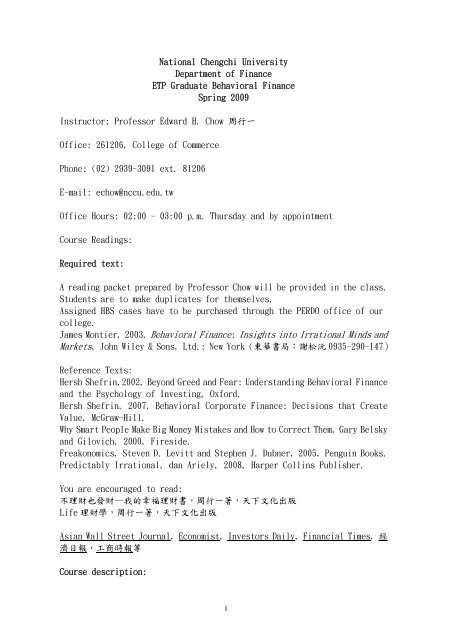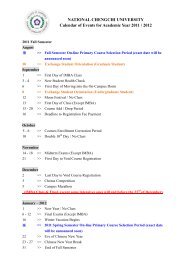James Montier, 2003, Behavioral Finance: Insights into Irrational ...
James Montier, 2003, Behavioral Finance: Insights into Irrational ...
James Montier, 2003, Behavioral Finance: Insights into Irrational ...
You also want an ePaper? Increase the reach of your titles
YUMPU automatically turns print PDFs into web optimized ePapers that Google loves.
National Chengchi University<br />
Department of <strong>Finance</strong><br />
ETP Graduate <strong>Behavioral</strong> <strong>Finance</strong><br />
Spring 2009<br />
Instructor: Professor Edward H. Chow 周行一<br />
Office: 261206, College of Commerce<br />
Phone: (02) 2939-3091 ext. 81206<br />
E-mail: echow@nccu.edu.tw<br />
Office Hours: 02:00 - 03:00 p.m. Thursday and by appointment<br />
Course Readings:<br />
Required text:<br />
A reading packet prepared by Professor Chow will be provided in the class.<br />
Students are to make duplicates for themselves.<br />
Assigned HBS cases have to be purchased through the PERDO office of our<br />
college.<br />
<strong>James</strong> <strong>Montier</strong>, <strong>2003</strong>, <strong>Behavioral</strong> <strong>Finance</strong>: <strong>Insights</strong> <strong>into</strong> <strong>Irrational</strong> Minds and<br />
Markets, John Wiley & Sons, Ltd.: New York (東華書局:謝松沅 0935-290-147)<br />
Reference Texts:<br />
Hersh Shefrin,2002, Beyond Greed and Fear: Understanding <strong>Behavioral</strong> <strong>Finance</strong><br />
and the Psychology of Investing, Oxford.<br />
Hersh Shefrin, 2007, <strong>Behavioral</strong> Corporate <strong>Finance</strong>: Decisions that Create<br />
Value, McGraw-Hill.<br />
Why Smart People Make Big Money Mistakes and How to Correct Them, Gary Belsky<br />
and Gilovich, 2000, Fireside.<br />
Freakonomics, Steven D. Levitt and Stephen J. Dubner, 2005, Penguin Books.<br />
Predictably <strong>Irrational</strong>, dan Ariely, 2008, Harper Collins Publisher.<br />
You are encouraged to read:<br />
不理財也發財—我的幸福理財書,周行一著,天下文化出版<br />
Life 理財學,周行一著,天下文化出版<br />
Asian Wall Street Journal, Economist, Investors Daily, Financial Times, 經<br />
濟日報,工商時報等<br />
Course description:<br />
1
This course is designed to introduce <strong>Behavioral</strong> <strong>Finance</strong> to students.<br />
<strong>Behavioral</strong> finance is applied to all aspects of finance including investments<br />
and corporate finance. I expect you to have basic knowledge of corporate<br />
finance, investments and economics. An important part of this class is<br />
conducted through class discussion. In the first three lectures, an overview<br />
of behavioral biases that are related to finance will be overviewed. The<br />
behavioral biases related to finance include heuristic biases and frame<br />
dependence. The major heuristic biases include overconfidence,<br />
self-attribution, optimism, representativeness, anchoring and adjustment,<br />
conservatism, availability biases, and hindsight. Frame dependence includes<br />
loss aversion, ambiguity aversion, narrow framing, and mental accounts.<br />
Prospect theory, which is in contrast to expected utility theory, concerns<br />
itself with how decisions are actually made. It is based on the findings from<br />
experimental cognitive psychology. Prospect theory has two parts: a value<br />
function and a weighting function.<br />
Grading Structure (if students need to register in a course)<br />
Presentations 30%<br />
Participations and discussions 40%<br />
Term Paper 30%<br />
Students are required to present the assigned papers and to participate in<br />
the discussions. In addition, Students are required to write a term paper<br />
or a proposal. The term paper or proposal should be related to the topics<br />
covered in this course. The term paper or proposal could be either a<br />
replication of a published empirical paper (subject to approval by the<br />
instructor) or an original research topic.<br />
The flow of our discussion will basically follow the schedule below. My<br />
objective is very simple: to help you understand how behavioral finance is<br />
applied to investments and corporate finance. I will be the one who leads<br />
the discussion in class. However, I expect you to be very active in<br />
participating in the class discussion. A substantial part of your final<br />
grade (40%) will be determined by the quality of your participation, namely,<br />
the extent of your understanding of the class material, the quality of your<br />
discussion and the insight you provide to the class. You definitely will<br />
be called upon in each class to either discuss the class material or comment<br />
on a point in issue. You need to form work groups for all the work in this<br />
class. Each group consists of 3-4 students. In the fifth week you shall<br />
submit to me a one-page description of your topic. Please let me know why<br />
and how you are going to write the paper. In the final two meetings of the<br />
semester you need to present your paper in the class. The presentation time<br />
is 20 minutes, no more and no less. The paper needs to have the following<br />
components: the background of the paper, analysis of the issue,<br />
implications for readers, and references. I reserve the right to have a<br />
2
final examination. If the students perform well during the semester, then<br />
the final examination will be waved.<br />
Course outline<br />
1 Overview of Heuristic-Driven Biases, Frame Dependence, and Prospect Theory<br />
as well as an Introduction of Limits to Arbitrage<br />
Readings:<br />
Chpt. 1 and 2, <strong>Montier</strong><br />
Barberis, Nicholas, and Richard Thaler, <strong>2003</strong>, “A survey of behavior<br />
finance,” in Handbook of the Economics of <strong>Finance</strong>, G. Constantinides, M.<br />
Harris, and R. Stulz (ed.), North-Holland, Amsterdam.<br />
Fama, Eugene F., 1998, Market efficiency, long-term returns, and behavioral<br />
finance, Journal of Financial Economics 49, 283-306.<br />
Kahneman, D., <strong>2003</strong>, “Maps of bounded rationality: Psychology for behavioral<br />
economics,” American Economic Review 93, 1449-1475.<br />
Kahneman, Daniel, and Amos Tversky, 1979, Prospect theory: An analysis of<br />
decision under risk, Econometrica 47, 263-291.<br />
Malkiel, Burton G., <strong>2003</strong>, “The efficient market hypothesis and its<br />
critics,” Journal of Economic Perspective 17, 59-82.<br />
Shiller, Robert J., <strong>2003</strong>, “From Efficient Markets Theory to <strong>Behavioral</strong><br />
<strong>Finance</strong>,” Journal of Economic Perspective 17, 83-104.<br />
2 Overview of Heuristic-Driven Biases, Frame Dependence, and Prospect Theory<br />
as well as an Introduction of Limits to Arbitrage<br />
Readings:<br />
Same as above<br />
3 Overview of Heuristic-Driven Biases, Frame Dependence, and Prospect Theory<br />
as well as an Introduction of Limits to Arbitrage<br />
Readings:<br />
Same as above<br />
4 Limits of Arbitrage<br />
Readings:<br />
Chpt. 2, <strong>Montier</strong><br />
Ali, Ashiq, Lee-Seok Hwang, and Mark A. Trombley, <strong>2003</strong>, “Arbitrage risk and<br />
the book-tomarket anomaly,” Journal of Financial Economics 69, 355-373.<br />
Mitchell, M., T. Pulvino and E. Stafford (2002), “Limited arbitrage in<br />
equity markets,” Journal of <strong>Finance</strong> 57, 551−584.<br />
Ofek, Eli, Matthew Richardson, and Robert F. Whitelaw, 2004, “Limited<br />
arbitrage and short sales restrictions: Evidence from the options markets,”<br />
Journal of Financial Economics 74, 305-342.<br />
Owen A. Lamont and Richard H. Thaler (2004), “Can the market add and subtract?<br />
Mispricing in tech stock carve-outs,” Journal of Political Economy<br />
3
111:227−268.<br />
5 Limits of Arbitrage<br />
Readings:<br />
Same as above<br />
Remember to turn in your term paper proposal.<br />
6 Discuss your term paper proposal<br />
7 Style Investment<br />
Readings:<br />
Chpt. 3, <strong>Montier</strong><br />
Barberis, Nichole, Andrei. Shleifer and Jeffrey Wurgler, 2005,<br />
“Comovement,” Journal of Financial Economics 75, 283-317.<br />
Teo, Melvyn and Sung-Jun Woo, 2004, “Style effects in the cross-section of<br />
stock returns,” Journal of Financial Economics 74, 367-398.<br />
8 Stock Valuation<br />
Readings:<br />
Chpt. 4, <strong>Montier</strong><br />
9 Asset Allocation<br />
Readings:<br />
Chpt. 6, <strong>Montier</strong><br />
10 Corporate <strong>Finance</strong><br />
Readings:<br />
Chpt. 7, <strong>Montier</strong><br />
11 Applications of Prospect Theory (Empirical)<br />
Readings:<br />
Franzzini, Andrew, 2006, “The disposition effect and underreaction to<br />
news,” Journal of <strong>Finance</strong> 61, 2017-2046.<br />
Ljunqvist, Alexander and William Wilhelm, 2005, “Does prospect theory<br />
explain IPO market behavior?” Journal of <strong>Finance</strong> 60, 1759-1790.<br />
12 Trading behavior<br />
Barber, Brad M., and Terrance Odean, 2000, Trading is hazardous to your wealth:<br />
The common stock investment performance of individual investors,” Journal<br />
of <strong>Finance</strong> 55, 773-806.<br />
Elton, Edwin, Martin Gruber and Jeffrey A. Busse, 2004, “Are investors<br />
rational? Choices among index funds,” Journal of <strong>Finance</strong> 59, 261-288.<br />
13 Applications of <strong>Behavioral</strong> <strong>Finance</strong>: Security Design<br />
Case study: Shefrin, Hersh and Meir Statman, <strong>Behavioral</strong> Aspects of the Design<br />
4
and Marketing of Financial Products, Financial Management Summer 1993.<br />
123-134.<br />
14 Applications of <strong>Behavioral</strong> <strong>Finance</strong>: Advise for investors<br />
Kahneman, Daniel and Mark W. Riepe, Aspects of Investor Psychology: Beliefs,<br />
preferences, and biases investment advisors should know about, Journal of<br />
Portfolio Management Summer 1998, 52-65.<br />
Case study: Fisher, Kenneth L and Meir Statman, A <strong>Behavioral</strong> Framework for<br />
Time Diversification, Financial Analyst Journal May/June 1999, 88-97.<br />
15. Case Study: <strong>Behavioral</strong> <strong>Finance</strong> at JP Morgan, Malcolm Baker and Aldo Sesia<br />
Jr. (9-207-084)<br />
16 Term paper presentation<br />
17Term paper presentation<br />
I may invite speakers to give talks to you. To be announced.<br />
5



